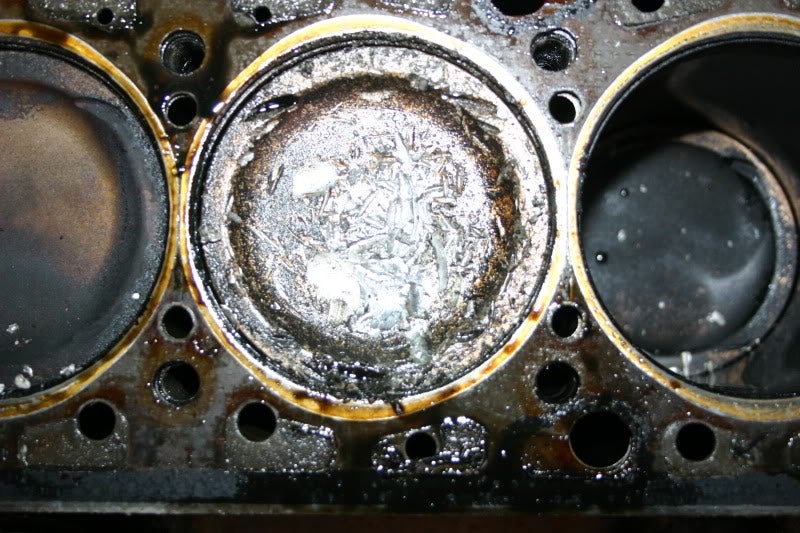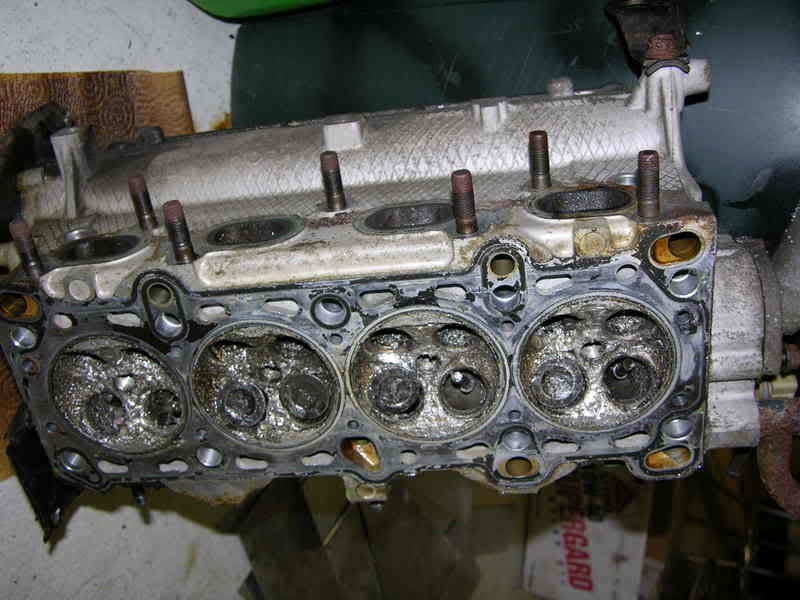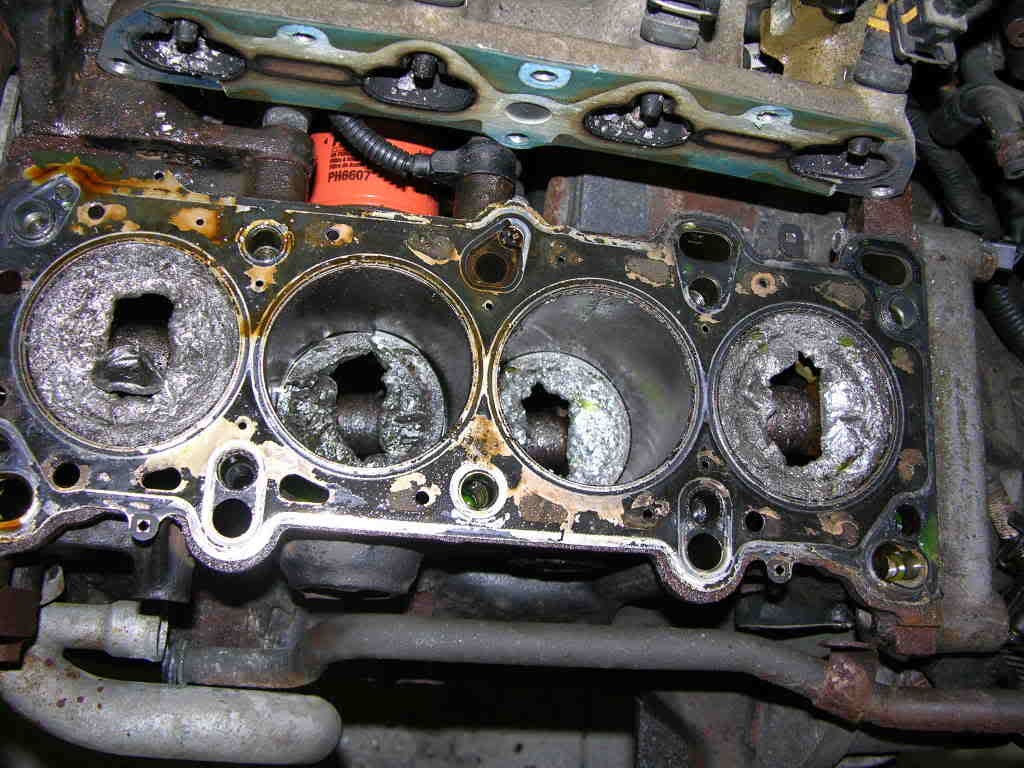 "FasTbird232" (fastbird232)
"FasTbird232" (fastbird232)
03/07/2014 at 10:29 • Filed to: None
 1
1
 30
30
 "FasTbird232" (fastbird232)
"FasTbird232" (fastbird232)
03/07/2014 at 10:29 • Filed to: None |  1 1
|  30 30 |
I should know the answer to this, but it happens to be something I've never actually thought about, until now (that I have to)...
If the valves get whacked, the motor is dead, right? I can't just replace the broken bits?
 quarterlifecrisis
> FasTbird232
quarterlifecrisis
> FasTbird232
03/07/2014 at 10:31 |
|
There could be salvagable things, but I would wager the heads, valvetrain, and possibly other rotating parts are done for.
 Slave2anMG
> FasTbird232
Slave2anMG
> FasTbird232
03/07/2014 at 10:32 |
|
Maybe. Depends on the damage. If you're lucky often it's "only" bent up valves and a holed piston or two. But often stray bits of metal get into other things and cause collateral damage...or conn rods get bent...or the head gets damaged....
 FasTbird232
> quarterlifecrisis
FasTbird232
> quarterlifecrisis
03/07/2014 at 10:33 |
|
So, it isn't just bent valves, it's the resulting shock to the entire rotating assembly?
Time for a new EJ22, hey?
 gt6xxer
> FasTbird232
gt6xxer
> FasTbird232
03/07/2014 at 10:33 |
|
In a valve whacking event, most of your reciprocating parts will be damaged. Most replacement engines cost less than the work required to fix all those parts. Plus, weird things happen in other places like water pumps, oil pumps, bearings and driveline due to the forces exerted on them. They are less obvious, but they usually end up causing other failures of critical parts. Its a bad domino effect.
 crowmolly
> quarterlifecrisis
crowmolly
> quarterlifecrisis
03/07/2014 at 10:33 |
|
This.
If they touch there is some stuff that MAY be OK, but if you end up wanting to crack open the motor for a rebuild you want to be sure you won't be doing it twice.
 Joe_Limon
> FasTbird232
Joe_Limon
> FasTbird232
03/07/2014 at 10:35 |
|
Ouch, I feel your pain bro, my engine detonated a couple days ago too.
 IDROVEAPICKUPTRUCK
> FasTbird232
IDROVEAPICKUPTRUCK
> FasTbird232
03/07/2014 at 10:37 |
|
The block should be fine at least...
 RamblinRover Luxury-Yacht
> FasTbird232
RamblinRover Luxury-Yacht
> FasTbird232
03/07/2014 at 10:37 |
|
Given that it usually means a new head, new pistons, and way more bottom end work than you probably are ready for, it's typically for all intents and purposes dead. Cam-on-valve relatively low-interference engines can sometimes just trash the pistons, some valves, valve guides, and cam + cam blocks, which is a pricey fix, but not an ultimate death to those somewhat determined.
 505Turbeaux
> FasTbird232
505Turbeaux
> FasTbird232
03/07/2014 at 10:39 |
|

om nom NOM
 FasTbird232
> gt6xxer
FasTbird232
> gt6xxer
03/07/2014 at 10:39 |
|
Last thing I want is to rebuild it, then have it break again.
Not worth the risk is what I'm getting here. Have to find another motor and build this one into a coffee table.
 Luc - The Acadian Oppo
> FasTbird232
Luc - The Acadian Oppo
> FasTbird232
03/07/2014 at 10:40 |
|
I had a timing belt skip on a Honda Civic and it bent 2 valves. I got the head rebuilt and it was good to go. I guess it would probably depend on how high the RPM were when it happened.
 FasTbird232
> 505Turbeaux
FasTbird232
> 505Turbeaux
03/07/2014 at 10:41 |
|
Holy Hell, that's not what I thought it would look like.
That's way worse.
 quarterlifecrisis
> FasTbird232
quarterlifecrisis
> FasTbird232
03/07/2014 at 10:43 |
|
That's the logic I'm using, is that once it goes bang, there could be things transfered to tthe cam from the shock.
 505Turbeaux
> FasTbird232
505Turbeaux
> FasTbird232
03/07/2014 at 10:46 |
|
that was just a single broken valve. With a snapped timing belt at speed multiply that times the number of cylinders :)
 FasTbird232
> 505Turbeaux
FasTbird232
> 505Turbeaux
03/07/2014 at 10:47 |
|
The horror... the horror...
 OPPOsaurus WRX
> FasTbird232
OPPOsaurus WRX
> FasTbird232
03/07/2014 at 10:49 |
|
The timing chain derailed on my Sport Trac. It killed 3 valves and both heads. By the time he tallied up all the repairs he said it would be better to replace the engine. It was about the same price but mostly labor. And who knows what else could go wrong int he process or what will give shortly after.
 gt6xxer
> FasTbird232
gt6xxer
> FasTbird232
03/07/2014 at 10:52 |
|
Its a lot of time and effort for a novice engine rebuilder to make sure its right. I'd get a replacement engine that has been certified healthy.
 The Opponaut formerly known as MattP123
> 505Turbeaux
The Opponaut formerly known as MattP123
> 505Turbeaux
03/07/2014 at 10:52 |
|
El Uly? Is that you? That looks terrible. I never understood why anybody would design an interference engine in the first place. Seems like it turns a minor inconvenience into a catastrophic failure.
 505Turbeaux
> The Opponaut formerly known as MattP123
505Turbeaux
> The Opponaut formerly known as MattP123
03/07/2014 at 10:54 |
|
It is a victim of emissions and the needs for more HP out of less displacement. The tolerances just keep getting closer and closer. My old Audi 5 cylinder N/A lump doesnt have this issue
 Doesn't Drive a BMW
> The Opponaut formerly known as MattP123
Doesn't Drive a BMW
> The Opponaut formerly known as MattP123
03/07/2014 at 10:55 |
|
Because interference engines allow much higher compression ratios than non interference engines, increasing both power and efficiency.
 Casper
> FasTbird232
Casper
> FasTbird232
03/07/2014 at 10:56 |
|
It all depends. I have seen engines that have munched valves just get new valves and put back on the road. I'm sure there was other damage other than the marks on the piston top, but the engine ran and the guys were on a budget. This isn't a good idea, if you are already tearing into the engine to fix this, just replace the whole thing. The cars I know about just valves being replaced on were all I4 or I6 engines where it was really fast to just pop the cover, swap parts, and get back to trashing them. I wouldn't do that with a boxer or any other engine that was much effort to work on and definitely not something that was a DD.
A random story, we broke the timing belt on a 91 CRX which is interference. It was at about 80 MPH and accelerating, the belt let go, and somehow even after that and the driver trying to restart it a few times, it never suffered any contact. Crazy.
 Drsweetdik
> FasTbird232
Drsweetdik
> FasTbird232
03/07/2014 at 11:01 |
|
I have seen these go both ways. Sometimes a few bent valves, sometimes a catastrophe. A mechanic with a camera should be able to look in the spark plug holes and get a general idea of how bad it is. Good luck!
 LuczOr
> FasTbird232
LuczOr
> FasTbird232
03/07/2014 at 11:09 |
|
This is a head from a Kia Rio after throwing the timing belt.

And here is the block!

 RickyD
> LuczOr
RickyD
> LuczOr
03/07/2014 at 15:42 |
|
Excuse me while I vomit
 RickyD
> LuczOr
RickyD
> LuczOr
03/07/2014 at 15:43 |
|
Excuse me while I vomit.
 Old-Busted-Hotness
> LuczOr
Old-Busted-Hotness
> LuczOr
03/08/2014 at 07:59 |
|
I'm guessing the belt skipped a few teeth at speed? If the belt broke the valvetrain would stop and only one or two cylinders would make contact.
 Old-Busted-Hotness
> Doesn't Drive a BMW
Old-Busted-Hotness
> Doesn't Drive a BMW
03/08/2014 at 08:03 |
|
Yeah, but look at the dished pistons. How hard would it be to put some valve-relief notches in there and make up the difference with a shallower dish? Yeah, you might lose a little bit of swirl/efficiency/whatever, but the insurance factor would be worth it.
On the other hand, timing belts don't break inside the warranty period so automakers don't really care.
 Doesn't Drive a BMW
> Old-Busted-Hotness
Doesn't Drive a BMW
> Old-Busted-Hotness
03/13/2014 at 16:32 |
|
The problem is, you lose a lot of efficiency. And with EPA and CAFE standards, as well as the consumer looking for power and efficiency, automakers want the same.
Think of it this way: changing your oil every x,000 miles is required, and everyone accepts that. Automakers could make a system that holds a reservoir of oil to flush the old one out automatically, but you would be lugging that around, and lose efficiency. Timing belts are the same. They're a maintenance item, and easily prevented by following the replacement intervals.
 Old-Busted-Hotness
> Doesn't Drive a BMW
Old-Busted-Hotness
> Doesn't Drive a BMW
03/13/2014 at 18:37 |
|
All I know is when the timing belt popped on my old Ranger, I changed it by the side of the road. I get the need for efficiency, but I'm willing to trade some for that ability.
 Doesn't Drive a BMW
> Old-Busted-Hotness
Doesn't Drive a BMW
> Old-Busted-Hotness
03/13/2014 at 18:58 |
|
Oh definitely, it comes down to what one needs though. Although you may want a car that's easier to work, the next person down doesn't look at that. And when they're looking at efficiency, power, and emissions, the interference engine will win every time.